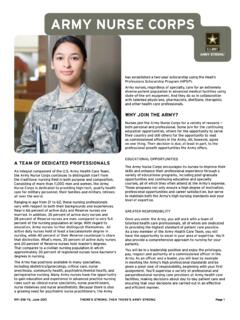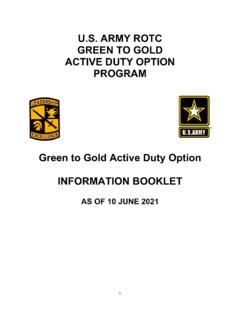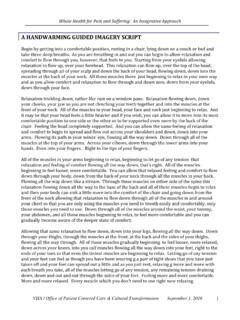Transcription of ARMY POCKET PHYSICAL TRAINING GUIDE - goarmy.com
1 ARMYPOCKET PHYSICAL TRAINING GUIDEP ocket PHYSICAL TRAINING GuideThis publication contains the following information:IntroductionGetting StartedSafety ConsiderationsInjury ControlShoesClothingEnvironmental ConditionsSigns and Symptoms of Heat InjuriesSigns and Symptoms of Cold Weather InjuriesHydration NutritionStandardized PHYSICAL TRAINING SessionWarm up Exercise Drills Standardized PHYSICAL TRAINING Activities Standardized Cool downRunningCalisthenicsStability Training4 for the core (4C) Hip Stability Drill (HSD)Conditioning Drill 1 (CD1)Military Movement Drill (MMD)Stretch Drill (SD)Conditioning Drill 2 (CD2)Conditioning Drill 3 (CD3) TRAINING SchedulesCONTENTSINTRODUCTIONThe following information is provided for individuals preparing for the PHYSICAL demands of Initial Military TRAINING (IMT).
2 The staff of the Army PHYSICAL Fitness School (USAPFS) prepared this POCKET PHYSICAL TRAINING GUIDE . This document is the sole property of United States Army TRAINING and Doctrine Command (TRADOC) and is intended for use by Army Recruiters to assist future GUIDE was written in recognition that both the quality and quantity of PHYSICAL activity recommended to the individuals using this GUIDE is consistent with current PHYSICAL activity recommendations for the general public. The fitness components of Cardiorespiratory endurance, muscular strength and endurance, flexibility, and body composition are all inherent within this generalized exercise prescription. This program specifies the intensity, duration, and frequency of TRAINING , and it is the interaction of these three variables that results in improved health and PHYSICAL fitness.
3 In order for this program to be safe and effective, it must be followed as written. Exercise must be conducted regularly at the proper intensity to bring about the desired changes in the body. However, changes in the body occur gradually; so be patient and adhere to the program. If you miss a session for some reason, just pick up where you left off with the next day s session. However, if you miss a whole week of sessions, you will have to start the week over. In addition, following the nutritional guidance in this document and ensuring adequate rest and recovery will optimize health, improve PHYSICAL fitness, and control injuries. DO NOT begin this PHYSICAL exercise program before passing a routine PHYSICAL examination at the Military Entrance Processing Station (MEPS).
4 INTRODUCTIONGETTING STARTEDYour PHYSICAL TRAINING program will begin with an assessment of your present PHYSICAL condition. Your Recruiter will administer an assessment (the 1 1 1 PHYSICAL Fitness Assessment), which consists of one minute of push ups, one minute of sit ups, and a timed, one mile run. This assessment will determine your starting point and appropriate placement in the Pre BCT Standardized PHYSICAL TRAINING Program. You and your Recruiter will review your scores to determine which TRAINING schedule you will follow. Commit to spending approximately 45 minutes per day, four to five times a week in the conduct of PHYSICAL TRAINING . Whether you follow the walk to run guidelines or begin TRAINING at a higher level, this program will help prepare you for the PHYSICAL requirements of IMT.
5 If you follow this TRAINING program, you will experience many of the health related benefits of PHYSICAL activity. Adherence to the Pre BCT PHYSICAL TRAINING Program begins your preparation for the successful completion of the IMT graduation requirement to pass the Army PHYSICAL Fitness Test (APFT). This test consists of two minutes of push ups, two minutes of sit ups, and a timed, two mile run. Performance standards are based on age and ConsiderationsThe Pre BCT Program is a safe and effective way to improve your PHYSICAL fitness. To achieve these results, it must be followed as written. ALWAYS perform the prescribed warm up and cool down before and after the TRAINING activity. Perform ONLY the prescribed number of sets and repetitions on the TRAINING schedule.
6 Proper form (precision) is more important than the sloppy execution of more repetitions. Perform ALL the exercises in the order listed for each drill. If you miss a day of TRAINING , pick up with the next day of the TRAINING schedule. Exercise with a TRAINING partner whenever a little muscle soreness is to be expected when beginning a new PHYSICAL TRAINING program, do not aggravate injuries by continuing to exercise when you are feeling pain or ControlInjuries are not uncommon during intense PHYSICAL TRAINING . Most injuries can, however, be prevented. Safety is always a major common injuries are caused by overuse, that is, exercising too much and too often and with too rapid an increase in the workload.
7 Most overuse injuries can be treated with rest, ice, compression and most common running injuries occur in the feet, ankles, knees and legs. Although they are hard to eliminate, much can be done to keep them to a minimum. Preventive measures include proper warm up and cool down. Failure to allow recovery between hard bouts of running can lead to overtraining and can also be a major cause of injuries. If you experience continuing or acute pain, see your footwear may play a role in injury prevention. Choosing a running shoe that is suitable for your particular type of foot can help you avoid some common running related injuries. It can also make running more enjoyable and help you get more mileage out of your shoes.
8 Always tie and untie shoes when putting them on and taking them off. Expect shoes to be comfortable when you try them on. If they are not, then do not buy them. How a shoe looks is not as important as proper fit or comfort. Replace running shoes when they begin to show visible wear or after 500 miles of use, whichever occurs first. The best shoe for you may not be the most expensive. Always try on both shoes and walk around the store to ensure they fit before purchasing. If possible, shop for shoes at the end of the day instead of in the morning. Your feet swell from being in shoes and moving around all clothing can also help prevent injuries. Ensure that you are wearing some sort of reflective material if exercising during hours of low visibility.
9 Clothes should be comfortable, light in color, and fit loosely in warm weather. Clothing may be layered according to personal preference in cold weather and gloves or mittens and ear protecting caps should be worn to prevent frostbite. Rubberized or plastic suits should NEVER be worn during exercise or the PHYSICAL Conditions Do not exercise in extremely hot or cold weather; try to find an alternate indoor location to reduce the risk of heat or cold injuries. Avoid exercising near heavily traveled streets and highways during peak traffic hours. Avoid exposure to pollutants before and during exercise, if possible (including tobacco). In areas of high smog concentrations, train early in the day or later in the evening.
10 Use a waterproof or sweat proof sunblock when exercising in warm weather to avoid sunburn. Follow the instructions on the bottle for proper and Symptoms of Heat InjuriesIf you experience any of the below symptoms of heat cramps, heat exhaustion, or heatstroke, immediately stop your PHYSICAL CrampsMuscular TwitchingCrampingMuscular Spasms in Arms, Legs or AbdomenHeat Exhaustion (Requires Medical Attention)Excessive ThirstFatigueLack of CoordinationIncreased SweatingCool/Wet SkinDizziness and/or ConfusionHeatstroke (MEDICAL EMERGENCY, DIAL 911)No SweatingHot/Dry SkinRapid PulseRapid BreathingComaSeizureDizziness and/or ConfusionLoss of ConsciousnessSigns and Symptoms of Cold Weather InjuriesDuring exercise in the cold, your body usually produces enough heat to maintain its normal temperature.














